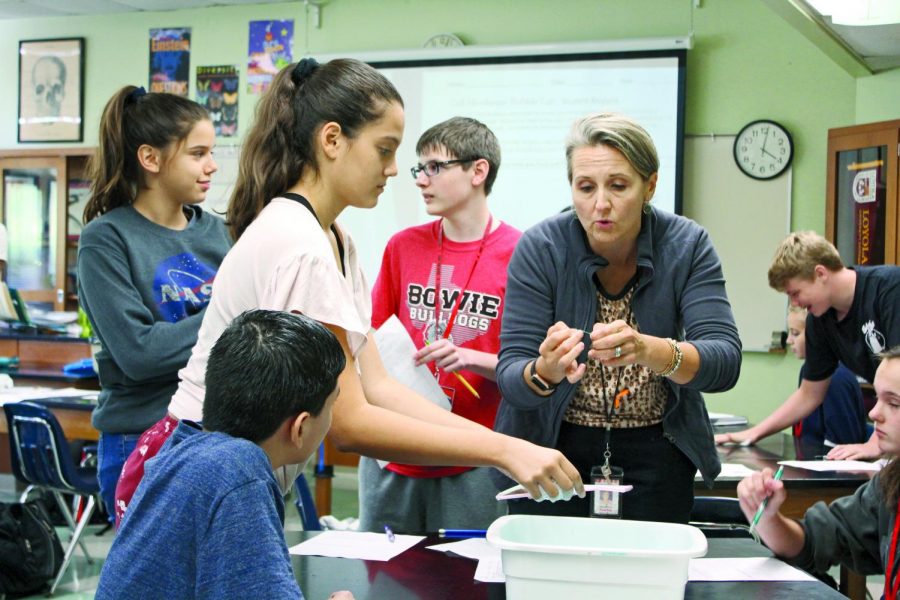Accountability ratings in
Texas Education Agency releases grades by campus
HANDS-ON DEMONSTRATION: Biology teacher Stacie Feen shows freshmen Sophia Moawad and Matthew Elam a demonstration of their lab. Feen teaches Pre-AP Biology.
October 12, 2018
OVERALL SCORE
Every year, the Texas Education Agency (TEA) evaluates different campuses and districts under what is called the Accountability Rating System. This year, Austin ISD had an overall score of 89 and Bowie got an overall score of 97.
Campuses are graded overall by the domains of Student Achievement, School Progress, and Closing the Gaps.
“I think Bowie got a great grade because it’s a great school,” principal Mark Robinson said. “And I think it’s a great school because we have conscientious students who have gifted teachers who set high expectations and who support students in reach of those high expectations.”
Within the overall domains, there are certain components. Under Student Achievement, there are three components: STAAR performance, College, Career and Military readiness, and Graduation rate.
“Bowie’s in pretty elite company in that not a lot of schools scored a 97,” Robinson said. “We have a core of really good teachers here, who put kids first, who understand that kids don’t care about how much you know until they know how much you care.”
Under the domain of School Progress, the two components are Academic Growth and Relative Performance. Bowie met the standard of every component. To student council president Cade Blagdan, Bowie deserves the grade.
“Despite the overarching amount of problems within the materialistic part of Bowie, I believe the community of teachers and students well represents this grade,” Blagdan said. “There are so many amazing classes with amazing teachers that will be there for you in more ways than education.”
THE DISTINCTIONS
In addition to meeting every criteria, Bowie earned six out of seven distinctions.
“I think everybody realizes that there is potential opportunity here is not only giving students a positive experience in high school but also building that academic resume that helps get them into that college that they want, the scholarship that they want, the job that they want and the life that they want,” Robinson said. “I feel like all of that is what makes it work.”
To earn a distinction, a school must perform in the top 15% of the schools in their comparison group.
“So when you take the best schools and then you put us in there and then we score in the top quartile, then that says we’re really doing something right, because we were able to earn six out of seven distinctions,” Robinson said.
The different distinction designations that were earned include Mathematics, Science, Social Studies, Comparative Academic Growth, Postsecondary Readiness, and Comparative Closing the Gaps. The only one not achieved was English Language Arts/Reading.
“We are working on our literacy model and the way that we are teaching English to make sure that it is the best practice that is getting the best result for students as far as being able to read critically, to write persuasively, and to write informatively,” Robinson said.
THE PREPARATION
School Improvement Facilitator Ruth Ann Widner credits the success of the campus to the teachers.
“One of the things is that we’ve been very strategic,” Widner said. “We understand what the expectations are. I think the strongest element is that our teachers are organized in their professional learning communities (PLCs) and so what the teachers are doing is they’re combining their skills. You’re putting lots of great minds together and really ensuring that the instructional piece is very, very strong.”
The first year the distinctions were introduced, Bowie earned three out the six. Since then, the campus has achieved a new distinction every year.
“So we earned six out of seven distinctions which is phenomenal,” Robinson said. “Over the years, we’ve added one every year and so to earn six out of seven is really solid, there were only a couple of other schools that were able to do that in our campus comparison group in our local area.”
IN COMPARISON
To determine what schools Bowie is competing against, there is a demographic profile compared across the state. The profile includes the number of students, the percentage of students that are economically disadvantaged, the mobility rate, the percentage of English language learners, and special education students. The schools with the most similar demographic profiles are put in comparison groups.
“There’s a commitment to excellence,” Widner says. “The motto out front says ‘Pride in Performance’ and that is in the classroom, it’s on the athletic fields, it’s in the dance competitions, it’s in the speech and debate tournaments. It manifests itself everywhere. There’s tremendous commitment to excellence and I think it’s part of the culture among the teaching staff and among the students.”
The schools in Bowie’s comparison group in the Austin area include Westlake High School, Lake Travis High School, Vandergrift High School, Round Rock High School, and Westwood High School.
“We’re not being compared with different schools in our district, no one in our district is in our comparison group,” mathematics instructional coach Cindi Carroll said. “So we’re compared with really great schools in the state. As we should be because we’re a really great school too. But that does make it really challenging.”
ATTENDANCE
One of the factors that play into the overall accountability rating is attendance. The greater the percentage of attendance, the higher the score.
“Attendance continues to be one of our big focuses that’s why we have the attendance incentive for painted parking spots, the exam substitutions, that’s why we talked about it a lot last year and we continue to talk about it this year,” Robinson said.
Last year, Bowie saw an attendance rate of 96%, putting them in the top of the second quartile. According to Robinson, the goal is the first quartile, where the minimum percentage is 96.5%.
“I believe attendance will become a larger part at Bowie due to this score,” student leadership senior Melania Dobson said. “Knowing these scores is helpful because it helps us understand the changes taking place with attendance.”
Attendance also plays a factor in school funding. The higher the percentage of attendance, the more funding the school receives. According to Robinson, last year Bowie lost over $900,000 in funding.
“It’d be really nice if we had those funds,” Robinson said. “Even if they’re not directly to the school, they’re in the district where they are accessible through budgets so that we can continue to develop our school community.”
DISTRICT WIDE
The TEA doesn’t just grade each individual campus. They grade the school districts as a whole as well. Austin ISD had an overall score of 89.
“I thought it was pretty impressive,” Widner said. “For a large, urban district, again really with some resource challenges, that they’re performing really well. I was pleased with the score.”
In the 2018 Accountability Ratings Overall summary for AISD, it states that the district did not receive an overall rating of an A due to at least one campus with an “overall or corresponding domain rating of ‘Improvement Required.’”
“I was proud of that B because in such a diverse district, with the schools being so different and with there being challenges all around, it’s a very different set of challenges for different schools and so I think that’s important for us to keep in mind, because we’re not a one high school district like Lake Travis or an Eanes ISD that makes it much more nimble, much easier to respond,” Robinson said. “Austin ISD is so big it’s like an ocean liner. It can turn but it’s going to take a little while.”
IN THE FUTURE
Overall, the past few years have seen Bowie’s improvement in earning a new distinction every year. To Widner, the improvement won’t stop anytime soon.
“That’s pretty unusual that you would see that kind of year-to-year increase,” Widner said. “What it’s saying is that we’re not plateauing as a school. What we’re doing is that our achievement is increasing year after year after year. So we’re really continuing to move towards excellence. I think it’s just the idea that it’s not stagnant, it’s not plateaued, its continuous and we’re not going to stop because every child deserves to have the highest quality education possible.”










